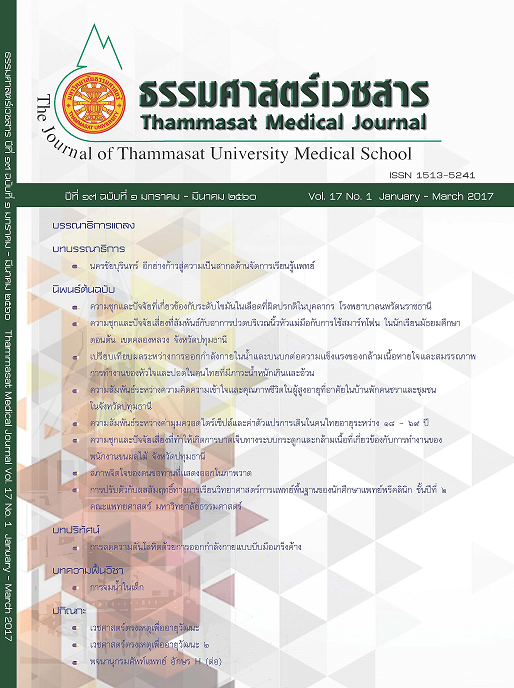Relationship between Q-angle and gait parameter in Thai aged 18 - 69
Keywords:
Q-angle, Gait analysis, Kinematic gait parameter, มุมควอดไดร์เซ็ปส์, การเดิน, ตัวแปรกลศาสตร์การเดินAbstract
Introduction: Quadriceps angle (Q-angle) is usually used as a clinical assessment measure to evaluate biomechanical function of knee joint. However, studies related to relationships between Q-angle and gait parameters in healthy people have been rarely reported. This study investigated the relationships between Q-angle and kinematic gait parameters in healthy Thai aged 18 - 69 years.
Method: One hundred and ten participants aged 18 - 69 years were divided into five age groups namely 18 - 29, 30 - 39, 40 - 49, 50 - 59 and 60 - 69 years (22 participants in each group). All participants were evaluated anthropometry of the body, measured Q-angle. Subsequently, 3D motion analysis (Vicon Mx system, Oxford Metrics Ltd., Oxford, UK) was used to assess kinematic gait parameters of the knee joint during walking on a walkway with individual preferred speed.
Result: There was significantly positive correlation (p < 0.05) between Q-angle and knee angular motion in sagittal plane whereas there was significantly negative correlation between Q-angle and knee angular motion in coronal plane (p < 0.05), the whole time of stance phase in age groups 30 - 39, 40 - 49 and 50 - 59 years.
Discussion and Conclusion:There were relationships between Q-angle and kinematic gait parameters. Therefore the result will be important baseline data for evaluating gait pattern or abnormal movement of patients with musculoskeletal or neurological impairment and for planning treatment effectively.
บทนำ: มุมควอดไดร์เซ็ปส์ถูกใช้เพื่อประเมินกลไกการทำงานของเข่าทางคลินิก แต่การศึกษาถึงความสัมพันธ์ระหว่างมุมดังกล่าวและการเดินในคนสุขภาพดียังพบได้น้อย การศึกษานี้มีวัตถุประสงค์เพื่อศึกษาความสัมพันธ์ระหว่างมุมควอดไดร์เซ็ปส์และตัวแปรกลศาสตร์การเดินในคนอายุ ๑๘ - ๖๙ ปี
วิธีการศึกษา: ผู้เข้าร่วมการวิจัยสุขภาพดี ๑๑๐ คน ถูกแบ่งเป็น ๕ กลุ่มช่วงอายุ ๑๘ - ๒๙ ปี ๓๐ - ๓๙ ปี ๔๐ - ๔๙ ปี ๕๐ - ๕๙ ปี และ ๖๐ - ๖๙ ปี กลุ่มละ ๒๒ คน ทุกคนถูกวัดสัดส่วนของร่างกาย มุมควอดไดร์เซ็ปส์ และเดินบนทางเดินที่กำหนดด้วยความเร็วปรกติเพื่อเก็บข้อมูลตัวแปรกลศาสตร์การเดินด้วยระบบวิเคราะห์การเคลื่อนไหวแบบสามมิติ
ผลการศึกษา: มุมควอดไดร์เซ็ปส์กับมุมการเคลื่อนไหวของข้อเข่าระนาบหน้า-หลังมีความสัมพันธ์กันในทิศทางเดียวกันขณะที่มีความสัมพันธ์ในทิศทางตรงข้ามกับมุมการเคลื่อนไหวของข้อเข่าระนาบซ้าย-ขวาอย่างมีนัยสำคัญทางสถิติ (p < ๐.๐๕) ในกลุ่มช่วงอายุ ๓๐ - ๓๙ ปี ๔๐ - ๔๙ ปี และ ๕๐ - ๕๙ ปี
วิจารณ์ และสรุปผลการศึกษา: มุมควอดไดร์เซ็ปส์มีความสัมพันธ์กับตัวแปรกลศาสตร์การเดิน ดังนั้นอาจเป็นข้อมูลพื้นฐานเพื่อใช้วิเคราะห์การเดินหรือการเคลื่อนไหวที่ผิดปรกติในผู้ป่วยระบบกระดูกและกล้ามเนื้อหรือระบบประสาทได้อย่างมีประสิทธิภาพยิ่งขึ้น



